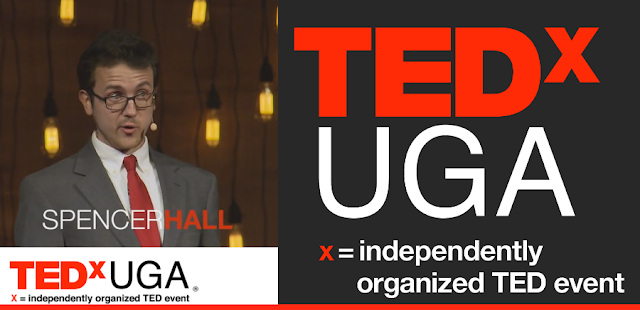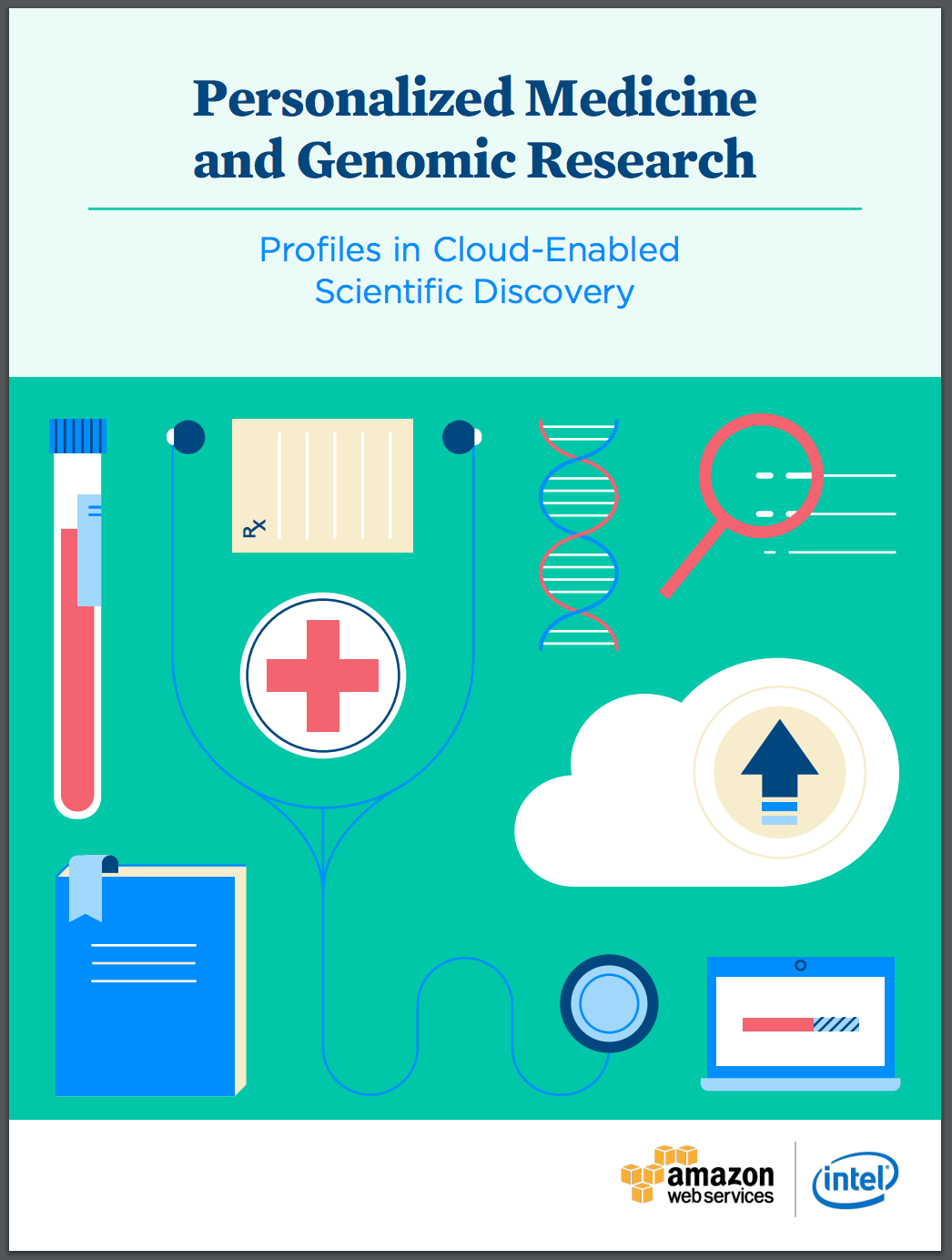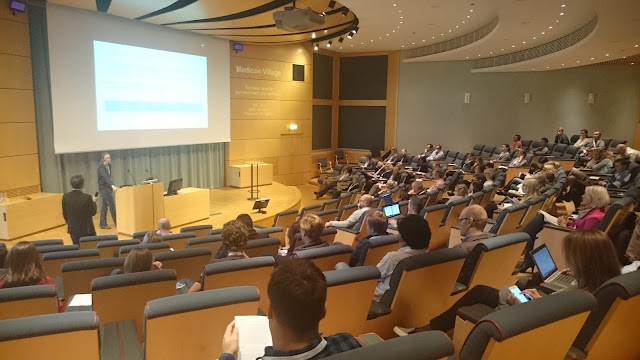Think your DNA is all human? Think again. And a new discovery suggests it's even less human than scientists previously thought.Nineteen new pieces of non-human DNA -- left by viruses that first infected our ancestors hundreds of thousands of years ago -- have just been found, lurking between our own genes.
[fquote]The simple reason that software has bugs (that result in errors) is that writing software is hard.Let's take a simple example and say you want to write some software to determine if a genetic variant meets an autosomal recessive inheritance pattern. This is easy, right!? Just find sites where the affected parent is het, the unaffected is homozygous reference and the proband is heterozygous. Done. Too easy.[/fquote]
[accordion]
[item title="£75M investment in bioinformatics"]UK Minister for Universities and Science David Willetts joined key stakeholders in the Cambridge biotechnology cluster today to celebrate the opening of a new Technical Hub for bioinformatics.
The European Bioinformatics Institute's new South Building will be home to the ELIXIR Directorate, which will coordinate bioinformatics activities throughout Europe in order to increase the availability and uptake of biological data in commercial and non-commercial.
Read More[/item]
[item title="Scientists develop high-sensitivity software for searching massive DNA databases"]A new computer program was designed by Russian and American scientists and specialized for searching massive DNA databases for distant similarities, reports Institute for information transmission problems of the Russian Academy of Sciences (IITP RAS) press-service. Anna Kaznadzey, a junior researcher at IITP RAS took part in this work.
Read More[/item]
[item title="Teaching children how to be a sequence "]As part of a PhD it is anticipated1 that you will share your science with various audiences; fellow PhD students, peers in the field and the various publics. Every year, the university
celebrates British Science Week with a Science Fair, inviting possibly the most difficult public to engage with: children. Over three days the fair serves to educate and entertain 1700 pupils from over 30 schools based across Mid Wales, and this
year I volunteered2 to run a stand.
Read More[/item]
[item title="ISCB’s initial reaction to New England Journal of Medicine"]The recent editorial by Dr Longo and Dr Drazen in the New England Journal of Medicine (Longo and Drazen, 2016) has stirred up quite a bit of controversy. As Executive Officers
of the International Society of Computational Biology, Inc. (ISCB), we express our deep concern about the restrictive and potentially damaging opinions voiced in this editorial, and while ISCB works to write a detailed response, we felt it
necessary to promptly address the editorial with this reaction. Although some of the concerns voiced by the authors of the editorial are worth considering, large parts of the statement purport an obsolete view of hegemony over
Read More[/item]
[item title="Assistant Professor of Bioinformatics "]The Department of Molecular and Biomedical Sciences at the University of Maine is seeking to fill a tenure-track position at the Assistant Professor level in the area of Bioinformatics/Computational
Biology. The successful applicant will establish and lead a productive research program in the areas of bioinformatics/computational biology that provides research opportunities for both undergraduate and graduate students. Specific research areas of interest for this position include but are not limited to genomics and systems biology
including gene expression, evolution, population genetics, and microbiomics. Analysis of other datasets such as lipidomics, metabolomics, transcriptomics, epigenomics, etc. are also of interest. The Department of Molecular and Biomedical Sciences has an active research core in the areas of host-pathogen interactions, toxicology, and cell signaling, and an outstanding zebrafish facility that supports broad research areas. Other units on campus also offer areas for collaboration such as wildlife genomics, mouse models, and others. As a founding and active member of The University of Maine's Graduate School of Biomedical Sciences and Engineering, the reach and collaborations available to members of the Department extend to the physical and computational sciences and to institutions across the state of Maine, including the Mt. Desert Island Biological Laboratory, The Jackson Laboratory, and Maine Medical Center Research Institute. The department is actively developing a new Masters degree program in Bioinformatics and includes a phage genomics course in its undergraduate core curriculum. The applicant will teach within the Department of Molecular and Biomedical Sciences with emphasis on the development of new courses in computational biology at the advanced undergraduate and graduate level. The position is a 75% research/25%
teaching position with a start date of January 1, 2017 or later.
Read More[/item]
[item title="Will Spark Power the Data behind Precision Medicine?"]The promise of precision medicine that President Obama envisions with this statement is a far-reaching goal that will require sweeping changes to the ways physicians treat patients, health data is collected, and global collaborative research is performed. Precision medicine typically describes an approach for treating and preventing disease that takes into account a patient’s individual variation in genes, lifestyle, and environment. Achieving this mission relies on the intersection of several technology innovations and a major restructuring of health data to focus on the genetic makeup of an individual.
Read More[/item]
[item title="Paper: “Undergraduate Bioinformatics Workshops Provide Perceived Skills”"]Bioinformatics is becoming an important part of undergraduate curriculum, but expertise and well-evaluated teaching materials may not be available on every
campus. Here, a guest speaker was utilized to introduce bioinformatics and web-available exercises were adapted for student investigation. Students used web-based nucleotide comparison tools to examine the medical and evolutionary relevance of a
unidentified genetic sequence. Based on pre- and post-workshop surveys, there were significant gains in the students understanding of bioinformatics, as well as their perceived skills in using bioinformatics tools. The relevance of bioinformatics to a student’s career seemed dependent on career aspirations.
Read More[/item]
[item title="More ancient viruses lurk in our DNA than we thought"]Think your DNA is all human? Think again. And a new discovery suggests it's even less human than scientists previously thought.Nineteen new pieces of non-human DNA -- left by
viruses that first infected our ancestors hundreds of thousands of years ago -- have just been found, lurking between our own genes.
Read More[/item]
[item title=" What is the reason for most software errors in Bioinformatics "]The simple reason that software has bugs (that result in errors) is that writing software is hard.Let's take a simple example and say you want to write some software to
determine if a genetic variant meets an autosomal recessive inheritance pattern. This is easy, right!? Just find sites where the affected parent is het, the unaffected is homozygous reference and the proband is heterozygous. Done. Too easy.
Read More[/item]
[item title="International Conference on Bioinformatics and Computational Biology (BICoB)"]In recent years, computational biology and medical informatics have seen significant advances driven by computational techniques in bioinformatics making
bioinformatics and computational biology among the most vibrant research areas. The 7th international conference on Bioinformatics and Computational Biology (BICoB-2016) provides an excellent venue for researchers and practitioners in the fields of bioinformatics and computational biology to present and publish their research results and techniques. The BICoB conference seeks original and high quality papers in the fields of bioinformatics, computational biology, systems biology,
medical informatics and the related disciplines.
Read More[/item]
[item title="The 100 Best Bioinformatics(Computer Science) Programs in the World"]At Princeton, one can research problems in Bitcoin and Crypto currencies, bioinformatics, computational neuroscience, geo-replicated cloud storage and any number of other leading subfields of information theory. Not surprisingly given Princeton’s focus, all its students, even undergraduates, are required to do at least one design or research-related project before graduation.
Read More[/item]
[item title="Software Architecture Training Conference in La Jolla"]creating applications for bioinformatics, finance, and retail. To make byte code more accessible, he created the open-source Java Assembler Kit (JAK) which provides a fluent API for producing Java byte code and includes a REPL to allow for interactive experimentation.
Read More[/item]
[item title="Wellcome Trust and COAF Open Access Spend, 2014-15"]Once a year we ask all those institutions in receipt of an open access (OA) grant from the Trust to provide details on how the grant has been spent. In 2014 six research funders established the Charity Open Access Fund (COAF) in order to provide a single funding mechanism to cover Article Processing Charges (APCs). The data supplied by institutions for the 2014-15 report therefore covers APC spend on articles arising from research funded by Arthritis Research UK, Breast Cancer Now, Bloodwise, British Heart Foundation, Cancer Research UK and the Wellcome Trust.
Read More[/item]
[item title="A new approach to sequence and assemble primate genomes"]A new sequencing technology based on longer sequence reads allows missing genes and missing forms of genetic variation to be discovered for the first time. This assembly offers
new biological insights into a living species that is second only to chimps in its evolutionary closeness to humans.
Read More[/item]
[item title="Science relies on computer modelling"]From the transforming discovery of penicillin to the theories of relativity and quantum mechanics, science progressed with mind-boggling speed even before there were computers. Much of this is down to the robustness of the scientific method: scientific results are validated by being replicated and extended by other scientists.
Read More[/item]
[item title="MOOC Course Report: April 2016"]A big welcome to “Bioinformatics: Introduction and Methods” from Peking University! In this MOOC you will become familiar with the concepts and computational methods in the exciting interdisciplinary field of bioinformatics and their applications in biology, the knowledge and skills in bioinformatics you acquired will help you in your future study and research.
Read More[/item]
[item title="Roche and Discuva in superdrug partnership"]The two companies announced on 28 February that they have entered a collaboration and licence agreement for the discovery and the development of antibiotics. The drugs are to treat infections
caused by multi-drug resistant Gram-negative bacteria using Discuva’s Selective Antibiotic Target IdentificatioN (SATIN) technology. This next-generation sequencing and bioinformatics platform will be used to identify bacteria and select promising drug candidates.
Read
More[/item]
[item title="Sample size calculation while controlling false discovery "]RNA-Sequencing (RNA-seq) experiments have been popularly applied to transcriptome studies in recent years. Such experiments are still relatively costly. As a result, RNA-seq experiments often employ a small number of replicates. Power analysis and sample size calculation are challenging in the context of differential expression analysis with RNA-seq data. One challenge is that there are no closed-form formulae to calculate power for the popularly applied tests for differential expression analysis. In addition, false discovery rate (FDR), instead of family-wise type I error rate, is controlled for the multiple testing error in RNA-seq data analysis. So far, there are very few proposals on sample size calculation for RNA-seq experiments.
Read More[/item]
[item title="24 phenomenal founders crashing the tech party"]A mathematician with a PhD in molecular evolution and bioinformatics, Nora Khaldi founded Nuritas in 2014 to ‘make the future of food’. Combining AI and DNA sequencing, Khaldi’s pioneering approach to bioinformatics has seen the company revolutionise how we study food. Khaldi will be speaking at Inspirefest this summer.
Read More[/item]
[/accordion]




























